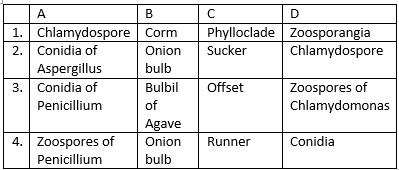Examine the figures A, B, C and D. in which one of the
four options, all the labels for A, B, C and D are correct?


four options, all the labels for A, B, C and D are correct?


Which one of the following plant does not show
dioecious condition:-
1. Marchantia
2. Papaya
3. Date palm
4. Coconut
A : All organisms have to reach a certain stage of growth and maturity in their life, before they can reproduce sexually.
B : Male and female gametes must be physically brought together to facilitate syngamy :-
1. A - correct B - incorrect
2. Both A and B are correct
3. Both A and B are incorrect
4. A - incorrect B – correct
These are two statements related to sexual reproduction :
(I) In both plants and animals, hormones are responsible for the transitions between the three phases.
(II) Interaction between hormones and certain environmental factors regulate the reproductive processes and the associated behavioural expressions of organisms.
Options :
1. Both (I) and (II) is correct
2. Only (I) is correct
3. Only (II) is correct
4. Neither (I) nor (II) is correct
Leaves of which of the following plants are involved in vegetative reproduction?
1. Opuntia
2. Potato
3. Bryophyllum
4. Sugarcane
Select the correct sequence of events.
| 1. | Gametogenesis → Gamete transfer → Syngamy → Zygote → Cell division (Cleavage) → Cell differentiation → Organogenesis |
| 2. | Gametogenesis → Gamete transfer → Syngamy → Zygote → Cell division (Cleavage) → Organogenesis → Cell differentiation |
| 3. | Gametogenesis → Syngamy → Gamete transfer → Zygote → Cell division (Cleavage) → Cell differentiation → Organogenesis |
| 4. | Gametogenesis → Gamete transfer → Syngamy → Zygote → Cell differentiation → Cell division (Cleavage) → Organogenesis |
Statement A - In seed plants, both male and female
gametes are non-motile.
Statement B - In spermatophytes, pollen grains are
the carrier of male gametes.
1. Only statement A is correct.
2. Only statement B is correct.
3. Both statements A and B are incorrect.
4. Both statements A and B are correct
Gamete formation always occurs in
(i) Sexual reproduction.
(ii) Asexual reproduction.
(iii) Parthenogenesis.
1. (i) only
2. (i), (ii), (iii)
3. (i) and (iii) only
4. (i) and (ii) only
Meiosis occurs in
1. Megaspore
2. Meiocyte
3. Conidia
4. Gemmule
In which set of organisms does external fertilization occur
1. Echinodermata and mosses
2. Hemichordata and ferns
3. Amphibians and algae
4. Reptiles and gymnosperms


